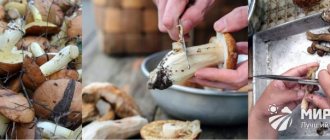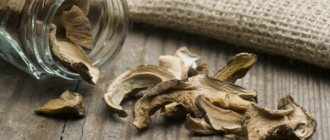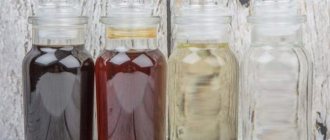Mushrooms add variety to the diet and bring pleasure to many people because they are healthy and tasty. They are rich in vitamins, proteins and carbohydrates; young specimens contain many microelements necessary for the body: iodine, iron, zinc, calcium. A beautifully prepared mushroom dish improves metabolism, activates the gastrointestinal tract (gastrointestinal tract) and nervous system. Many people love “silent hunting,” but not everyone knows how to distinguish an edible mushroom from an inedible one.
How to identify poisonous mushrooms - the most reliable method
People have many ways to test mushrooms for toxicity, but all of them are unreliable and are designed to detect a single poison. Accurate identification is possible only on the basis of characteristic features by which deadly types of mushrooms can be accurately identified. If you come across a dubious specimen whose identification you doubt, proceed as follows: Look at the inside of the cap to determine whether the unidentified specimen belongs to lamellar or tubular mushrooms. All the most poisonous mushrooms are lamellar. For example, fly agarics and toadstools. Therefore, be especially wary of such mushrooms. Look carefully at the bottom of the mushroom. Fly agarics and toadstools of all varieties have an ovoid thickening in the lower part of the leg. Look to see if there is a collar ring on the leg. It is located approximately in the middle - a little closer to the cap. If the mushroom has a “skirt,” throw it away as soon as possible.
How to provide first aid in case of poisoning?
If poisoning occurs, you need to consult a doctor as soon as possible. Before the ambulance arrives, it is recommended to drink more fluids; milk, water with a small amount of potassium permanganate or salted water will do. You can rinse the stomach and artificially induce vomiting several times. It is better to take a horizontal position. You can put a bandage soaked in cold water on your forehead, but you can warm your legs and stomach with a heating pad or blanket. There must be someone near the victim who has not eaten mushrooms, so that if the patient loses consciousness, they can give him a sniff of ammonia. In a state of poisoning, the victim should not remain unconscious for a long time, otherwise he may fall into a coma.
http:
You should not go into the forest to pick mushrooms without knowing their classification and what edible and poisonous specimens look like. Under no circumstances should you take children with you on a quiet hunt, because they may not only pick up a poisonous mushroom, but also manage to lick it or bite off a little. Edible mushrooms have twins, toadstools, which have slight differences, without knowing which you can easily make a mistake in your choice.
Misconceptions about recognizing edible and poisonous mushrooms
The people have several signs for identifying poisonous individuals, and many of them are erroneous. For example: Edible specimens are believed to be pleasant to the taste. Not true - fly agaric mushrooms are also tasty. Young fungi are safe; toxicity comes with age. This is not true, especially regarding the toadstool - it is deadly at any age. Poisonous mushrooms smell unpleasant. Nothing like this. Many poisonous and conditionally edible specimens have a pleasant aroma, while many have no odor at all. Representatives of the inedible category usually have an unpleasant odor. There is a widespread belief that poisonous mushrooms are not wormy - they are supposedly not to the taste of insects. Taking mushrooms that have been eaten away by worms and nibbled by snails into a basket, mushroom pickers think that these mushrooms are definitely edible. In fact, insects can live in any mushroom. Many are sure that alcohol neutralizes poison. Not true again. This misconception is especially dangerous - alcohol, on the contrary, contributes to the intoxication of the body with mushroom poison. If you drink poisonous mushrooms with alcohol, the likelihood of death increases. The opinion about the benefits of boiling mushrooms is also erroneous - boiling does not get rid of all poisons. There are toxins that are neutralized after boiling, and there are others that are resistant to high temperatures.
Debunking myths
Often, a novice mushroom picker, going into the forest, still has little knowledge of what the main difference is between edible mushrooms and their poisonous counterparts. But most beginners are confident that they will be able to collect only edible prey.
The most important myth, that if you test mushrooms using onions, garlic or some other food components for toxicity, you can avoid food poisoning, has already been debunked earlier. But there are several more equally dangerous misconceptions:
- All young mushrooms are safe to eat. In most cases this is true, but some species are highly poisonous even at a “young age”. For example, accidentally introducing a small toadstool fungus while preparing a dish can be fatal. Experience will come with time, but for beginners it is better to collect only well-known species.
- Everything edible smells delicious. This is a mistake: fly agarics, despite their toxicity, have a pleasant smell.
- Worms don't eat poison. It may seem that slightly nibbled mushroom caps serve as an indicator of non-toxicity and such mushrooms can be collected, but this is not entirely true. Some snails, worm larvae and other insects may simply be immune to fungal poison that is dangerous to humans.
- Prolonged boiling makes the product safe. Indeed, most poisons are eliminated by prolonged boiling with frequent changes of cooking water. But there are also heat-resistant poisons that, if they enter the body even in small quantities, can cause serious digestive disorders.
Silent hunting may no longer seem to many to be the safest it seemed at first. Indeed, very often you can accidentally put a poisonous mushroom instead of an edible one, and if testing mushrooms using onions, garlic or other food components does not provide a 100% guarantee of determining their safety for suitability for food. Beginners are advised to collect only familiar mushrooms and follow the recommendations of experienced mushroom pickers.
Control check
0
Source:
They don’t store mushroom trophies - as soon as they come from the forest, they immediately get to work - clean, wash and cook. A few hours will pass and all the loot will be spoiled. During cleaning, the mushrooms are carefully inspected so that not a single poisonous one slips through. Put old specimens aside - after cooking they will soften and be tasteless, they can even cause poisoning.
0
Source:
Popular “testing” People have come up with a lot of methods that allow them to identify poisonous representatives of the mushroom world. Unfortunately, many of them are not effective, since they are designed for the reaction of a specific poison or group of poisons. Moreover, many methods are erroneous, and the price of error is human lives. Let's figure out what methods there are, what exactly they define, and why they cannot be trusted. Testing with silver There is a popular belief that toxicity can be detected using silver objects. This is a flawed method that should not be relied upon. Silver darkens not from poisons, but from certain amino acids, which can be contained in any mushrooms, regardless of their edibility. Checking with garlic and onions Mushroom pickers have another way to check for quality - already during cooking. Throw an onion or garlic into the pan. If there is a poisonous specimen there, they turn blue. I have to throw away undercooked soup. But onions or garlic turn brown not at all from poison, but because of tyrosinase - this is a special enzyme that has no connection with edibility - it can be contained in both toxic and edible specimens. What will the insects tell you? Among some mushroom pickers there is a belief that poisonous mushrooms are not eaten by insects. In fact, the presence of insects does not mean anything - among them there are species resistant to poisons. Testing with milk It is believed that milk that gets on the body of a poisonous mushroom will curdle. In fact, folding is caused by the enzyme pepsin, which can be found in any form - edible and toxic. Vinegar test It is believed that boiling in a solution of vinegar and salt helps neutralize toxins. Indeed, this is how you can protect slightly toxic species, for example, stitches. But such manipulations are not scary for the pale grebe; its poison remains strong no matter how it is processed. Recognition by color of plates Color of subcap plates. The pinkish plates are said to indicate harmlessness. Not certainly in that way. It’s true that the champignon has pink plates, but the yellowing champignon and entoloma, both poisonous species, also have a pinkish tint. Recognition by fault Fault color. It is believed that if the color of the flesh at the break suddenly turns red or purple, there is poison in the mushroom body. But, for example, edible hornbeams turn purple on the fault, and hornbeams turn blue.
Recommendations from experienced mushroom pickers
To avoid being included in medical statistics reporting food poisoning at the height of the mushroom season, beginners are advised to:
- Carefully study the mushroom varieties characteristic of the area and their poisonous counterparts. It is advisable to do this while traveling. That is, make your first trip to the forest together with an experienced friend who will give you the first lessons in the difference between edible and inedible.
- Never take questionable prey. If there are doubts about the safety of the mushrooms found, then it is not recommended to collect them: it is better to return from the forest with an incomplete basket than to later be poisoned by a questionable product.
- Don't put off checking for too long. Professionals recommend checking your prey immediately after leaving the forest, and this is valuable advice, because the fragile mushroom bodies can break on the way home. In addition, particles of poison from accidentally collected poisonous mushrooms may remain on them. The ideal option is when the mushroom picker, having left the forest, lays out his catch from the basket on the grass and, carefully sorting the catch, throws out all the questionable elements.
- Do not take overgrown mushrooms: even in edible fruiting bodies, as they age, toxic substances are deposited.
- Having brought the mushrooms home, it is recommended to repeat the sorting, and then immediately wash, peel and process them. Long-term storage of collected material in the refrigerator is unacceptable: drying, pickling, marinades or other types of preservation must be carried out within the first 24 hours after collection.
Another tip: do not pick mushrooms near chemical plants or busy highways, especially in dry weather. Harvested in these places, even carefully tested for edibility, can cause digestive upset due to the accumulation of toxic substances from car exhaust or industrial emissions. Despite the fact that some sources allow the consumption of such a product after long-term soaking (more than 3-4 hours), it is still better to avoid harvesting mushrooms in areas with increased release of toxic substances.
Can you get poisoned by edible mushrooms?
0
Source:
Even edible mushrooms can easily lead to poisoning. The reasons for the transformation of such mushrooms into a poisonous product: Bacteria. Once in the nutrient medium - the mushroom body, the bacteria multiply intensively. Sources of infection are soil, transportation containers, dirty hands. If mushrooms are not processed properly, you can develop bacterial poisoning. If mushrooms are fried or boiled, the bacteria are almost 100% killed. But salted mushrooms can fail if they were not prepared correctly - they lay in the same water for a long time, the ambient temperature was high, or they did not add enough salt to the marinade. Botulism. This scourge affects canned foods. The culprits of infection are clostridia spores. Pickled mushrooms stored without access to air can cause botulism. Toxins. Mushrooms, like sponges, absorb all the chemicals that surround them. Together with mushrooms grown somewhere in an industrial area or near farmland, heavy metals, herbicides, etc. can enter the body, causing severe intoxication. Binge eating. Mushrooms are considered heavy food. Their consumption should be moderate. And for people with gastrointestinal problems, kidney and liver diseases, they are generally contraindicated.
Classification
Classification of poisonous mushrooms
If edible mushrooms are classified according to several characteristics (in particular, structure), then poisonous ones have their own system of division into groups. According to how they affect the human body, there are 3 groups of poisonous mushrooms:
- Causes food poisoning (tiger row, satanic mushroom, tin entoloma).
- Affects the central nervous system (panther fly agaric, purple ergot).
- Cause severe poisoning with possible death (pale toadstool, stinking fly agaric).
All three categories are dangerous, but the mushrooms that are included in the third group are the most insidious. The fact is that for the first time after eating them, a person may not feel any changes. Some toxins begin to act in slow motion, thereby delaying the moment of seeking medical help.
There is another classification based on the content of certain toxins:
- Cyclopeptides . The most dangerous poisons. Signs of intoxication appear only after a day or two. Then feeling unwell may stop for a couple of days. A false feeling of recovery arises, after which the person’s condition deteriorates sharply and rapidly. Toxins hit the liver the hardest.
- Cortinarine and orellanine . Poisons affect mainly the stomach and kidneys. Causes pain, gastrointestinal upset and a strong feeling of thirst. Their danger lies in their delayed manifestation - after a week or two.
- Monomethylhydrazine . The toxin, unlike the previous ones, manifests itself very quickly - within a matter of hours after entering the body. However, it affects organs and systems no less.
- Koprin . The toxin has a negative effect only if it is mixed with alcohol shortly after entering the body. As a rule, indigestion and tachycardia occur.
- Muscimol and ibotenic acid . Causes poisoning and general malaise.
- Muscarine. A couple of hours after entering the body it causes fever without increasing body temperature.
- Bufotenin . General malaise only occurs when eating large quantities of mushrooms.
Interesting: White mushroom: description, what it looks like, where it grows, varieties, photos and videos
Also included in a separate group are mushrooms that can cause allergies.










